
Church Street
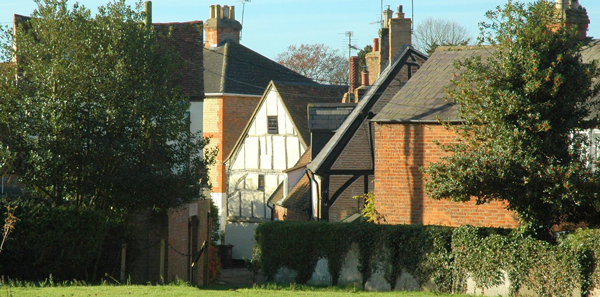
In this photo taken from the Churchyard you can see (left to right) 1 Church Street (behind tree), no.14, gable end of no.10, chimneys and dormer windows of nos.4-8, no.2 (partly behind tree). You can also see that Church Street rises quite steeply towards the church.
The name Church Street only seems to have come into regular use in the late 19th century. Before then it was treated as part of Horn Street (or occasionally the Churchyard), meaning that it is sometimes difficult to identify properties in earlier records. Here is a brief survey of the buildings, starting on the east side:
- 1 Church Street was described as being newly built in 1742.
- Eliot Hall was built by the Freemasons in 1930 on the garden of no.1. The 1880 map shows a range of buildings attached to no.1 which are not there on later maps.
- 2 Church Street (Pear Tree Cottage) consisted of two very small cottages in 1894. They were merged to form one "picturesque cottage" which was the residence of Hilda Hubbard from 1948. The house was extended considerably in 1956. Read more about the Walled Garden next to it.
- 4-8 Church Street now has three different roof levels but was originally a single 17th-century messuage, and a butcher's shop for much of the 19th century.
- 10-12 Church Street (The Old Homestead, Abbots House) can be traced back to 1685, and the land behind it retained the name of Peter Lowndes's Close after the man who bought it then. It was extended or partly rebuilt in 1727, but is originally 17th-century according to its Grade 2 listing.
- The Girls' School was built on 1865 on land donated from the Vicarage garden. Read more. After it was replaced as a school in 1901 it was acquired by the church and served as the Church Room until 1958, when the Girl Guides bought it.
- The Vicarage before it was rebuilt on a new site in 1863 stood at the end of the western spur of Church Street, and access was probably across the Girls' School site. Read more.
- 14 & 16 Church Street are two adjoining Victorian houses (probably 1870s) which replaced earlier buildings.
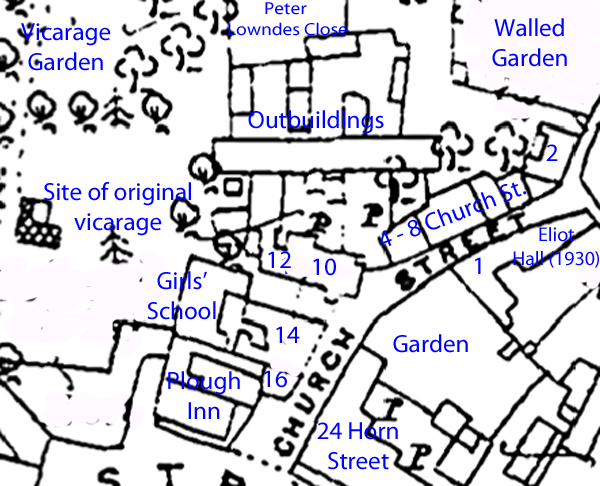
This map is based on the 1880 25" OS map
Seventeenth century
In 1685, the brickmaker Anthony Deely sold to Peter Lowndes "a tenement adjoining the messuage in which Antony now lives, now in the possession of Edward Illing, with the barn adjoining Antony's house, with the ground which lies in a direct line from the west side of the far post to the great willow, except the well and the passage 4 feet wide leading from the well to Antony's door and enclosed by him." This was probably 10-12 Church Street. See Peter Lowndes' will (proved 1711).
When he died in 1691 Anthony Deely owned "two messuages together near the Graveyard, one in his own occupation, the other late in the occupation of Ann wife of Henry Wyatt, the messuage of Peter Lowndes south. And a close of meadow or pasture adjoining the messuages, the Graveyard south-east, the Brickyard east." Anthony acquired a messuage and 2 acres from his father Thomas Deely in 1680, and another messuage from Henry and Ann Wyatt in 1683. This all probably refers to 4-8 Church Street and land to the north. Margaret Deely his widow inherited. See Anthony's will. Margaret immediately sold the property to Joseph Dandridge, merchant taylor of London. It was described as "a messuage at the Westgate of the graveyard of Winslow, with yard, orchard and houses".
Eighteenth century
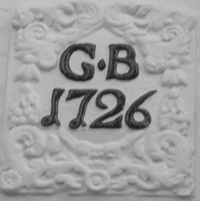 In 1724 George Barrett, glover, bought from Peter Lowndes jr a messuage which seems to have included the whole of what is now 10-12 Church Street. He extended it, or rebuilt part of it, as the initials G.B. and date 1726 in the left front wall show (photo, right). He doesn't seem to have lived in it himself (the occupier when he bought it was Richard Gibbs), and he subdivided it. Barrett died in 1747; see his will and inventory.
In 1724 George Barrett, glover, bought from Peter Lowndes jr a messuage which seems to have included the whole of what is now 10-12 Church Street. He extended it, or rebuilt part of it, as the initials G.B. and date 1726 in the left front wall show (photo, right). He doesn't seem to have lived in it himself (the occupier when he bought it was Richard Gibbs), and he subdivided it. Barrett died in 1747; see his will and inventory.
The west part (no.12) was sold in 1747 by Barrett's trustees to William Verney, glazier. Before 1771 it was acquired by Mark Morris of Thornton, dairyman and Ann his wife. Their son John Morris of Chackmore, yeoman, inherited and in 1786 sold it to Ann Morris, spinster (presumably his sister) who already lived in it. It was inherited by Mark Morris of Little Linford, who sold it in 1817 to John Morecraft for £65. At that date the occupant was John Redding.
When Barrett died, no.10 was “a messuage divided into two tenements” occupied by Widow Hinton and Joseph Norman, with an adjoining cottage occupied by William Goodman jr. In 1769 John Rawbone the vicar bought them from Barrett's trustees. The occupiers were Ann Goatman, John Cheney and Catherine Norman; the second and third were “heretofore in one but long since divided”. They were still divided into three in 1775 when Ann Morecraft, spinster, bought them from Rawbone's executors. She turned them into one house which she lived in, presumably until she got married in 1812 and went to live in London. In her will made in 1824 she says it is occupied by Mary Marsh, widow, or her under-tenants. Ann left it to her nephew John Morecraft, who inherited in 1837, bringing all the original house back into a single ownership although it remained subdivided. He also married Mary Marsh as his second wife.
George Barrett also owned a piece of land called Peter Lowndes' Close immediately north of the outbuildings. This was sold to the lawyer Ferdinando Southam. Southam went bankrupt and in 1762 it was sold to the surgeon Thomas Prentice. An adjacent barn and gateway with loft over were sold to Thomas Morecraft. Prentice (d.1780) left the land to his daughter Mary Ann, and it was later acquired by her sister Henrietta and brother-in-law John Tookey, another surgeon. They sold it with all outbuildings on it to Thomas Morecraft in 1798, by which time part had been converted into a garden.
The 1710 manor court refers to Joseph Dandridge's property (4-8 Church Street), now described as "the messuage now or late in the occupation of Sarah Hunt widow or her assigns; the adjoining close of meadow or pasture containing 3 roods; the cottage now or late in the occupation of Samuel Arnett or his assigns". Dandridge sold them to William Lowndes, whose records give more details. In 1746 Thomas Morecraft bought a messuage from John Hall and Mary his wife. It must be the same one if this reconstruction is correct, but the records of the relevant manor court don't survive and it is not known how the Halls acquired it from the Lowndes estate. Thomas Morecraft, butcher, died in 1793, leaving his messuage with shop, barn and outhouses to his widow Ann then to his son Thomas. The second Thomas Morecraft died in 1807. See his will, which refers to "three freehold messuages or tenements now in the several occupations of myself, John Bunce and Henry Holt" and a "copyhold messuage or tenement now in my own occupation". These were left to his widow Ann for her life, then to his son John.
In 1742 the surgeon Joseph Turner mortgaged "a messuage with the stable, outhouses, buildings, yards thereto adjoining lately new built by Joseph, and a piece of ground adjoining used as a garden, and a yard lying between the Garden rails and the Church yard" to his son John, who already lived in it. This was 1 Church Street, built on land which previously belonged to 32 Horn Street. John Turner sold it to John Harris, cordwainer, in 1758, and it was then inherited by his son, Grant Harris of London.
A cottage near The Plough, probably on the site of 16 Church Street, was inherited in 1771 by William Worsley, labourer, from his father Ralph. Ralph's wife Joan Church inherited it from her aunt Joan Markham in 1712. William handed it over to the overseers of the poor on condition that he and his wife Susanna could continue to live in it. An adjacent house belonged to Sarah King (d.1720), her daughter Sarah Goodman (d.1733), the latter's son John Goodman (d.c.1744) and his daughter Sarah.
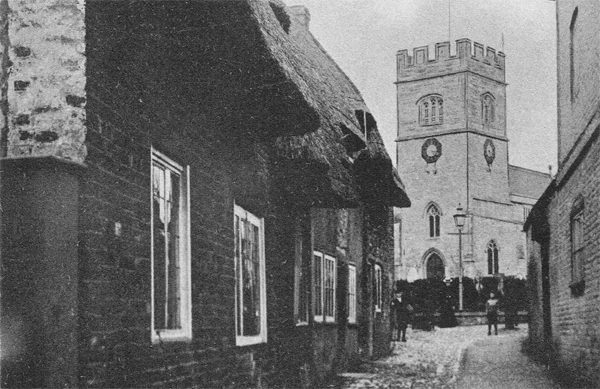
This early 20th-century view shows 4-8 Church Street on the left and no.1 on the right. The thatched roofs have since been replaced with slate or tile, and some of the brickwork has been rendered over.
19th century
From 1837 the whole block of property (4-12 Church Street) and the land to the north belonged to John Morecraft, butcher (1785-1859; see his will). John's death was followed within a few months by that of his son Thomas Morecraft (see his will). Thomas' widow Mary Gibbs Morecraft was left a life interest in the property. She lived at no.10, probably using the rear as a farmyard, until moving to Station Road, and it was only after her death that it was all put up for sale in 1894 (see below).
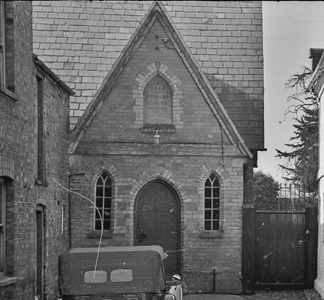 It's not known when the Morecrafts acquired 2 Church Street, which consisted of two small cottages. It's not in a list of the copyhold property of Thomas Morecraft in 1808, but might already have been freehold, or perhaps the Morecrafts built the cottages themselves. John Kingston and (probably) George Holt with their families lived there in 1838.
It's not known when the Morecrafts acquired 2 Church Street, which consisted of two small cottages. It's not in a list of the copyhold property of Thomas Morecraft in 1808, but might already have been freehold, or perhaps the Morecrafts built the cottages themselves. John Kingston and (probably) George Holt with their families lived there in 1838.
The Girls' School (photo, right) was built in 1865.
The lawyer Charles Willis (see Willis family) was tenant of 1 Church Street, and bought it when it was put up for sale by Grant Harris in 1807. It was advertised as:
A Neat and compact Copyhold MESSUAGE or TENEMENT, with Garden, Wash-House, Stable, and other convenient Out-offices thereunto adjoining and belonging, forming a very desirable Residence for a small genteel Family, pleasantly situate in WINSLOW aforesaid, and now in the Occupation of Mr Charles Willis, Solicitor, who will shew the Premises.
Willis later moved to 32 Horn Street. Land Tax returns show that 1 Church Street was occupied by Mrs Dover (1814), Mrs Tookey (1823) and Rev. Joseph Denton (1832). Mary Judge lived there in 1841. In 1845 Willis left it to his daughter Anna Maria. According to her will made in 1852 it was occupied by the curate Rev. James Thomas, by which time it must have been extended as he had 4 servants. She left it to her brothers.
In 1837 the Board of Guardians offered for sale many houses which were now surplus to requirements including "One Thatched Cottage in Great Horn Street, near the Plough public house, in the occupation of Elizabeth Westley". Her husband was the grandson of the Worsleys who handed it over to the overseers in 1771. It was probably on the site of 16 Church Street. Elizabeth was still living there in 1841; the Census gives her name as Wesley. Jane Walker lived next door.
In 1869, the trustees of the will of Thomas Lomath offered for sale "FOUR COTTAGES, with Stables and Chaisehouse adjoining, situate near the Plough, in Horn Street". George Dunkley bought for £57 10s a messuage now divided into two, "formerly in the occupation of Thomas Rivett & George Holt, afterwards Jane Walker & William Viccars, now Emma Holt & William Viccars" (sale on 23 Feb 1870 recorded at 1870 manor court). This is probably when the old houses were pulled down and replaced by the present 14-16 Church Street.
1851 Census
- Church Yard: Mary Whitehall, 78, pauper labourer's widow, b. Old Stratford
- Mary Kingston, 76, pauper labourer's widow, b. Winslow [2 Church Street]
- Church Street: James Thomas, 48, curate, b. Lymington + wife, 4 servants [no.1]
- Mary Elizabeth King, unm, 35, milliner & dressmaker, b. Whaddon [no.4]
- Thomas Morecraft, 36, butcher, b. Winslow + wife, 5 children, servant [nos.6-8]
- John Morecraft, 65, grazier, b. Winslow + wife, servant [no.10]
- William Keys, 40, domestic servant, b. Mursley + wife, lodger [no.12]
- Vicarage
- Thomas Rivett, 60, watchmaker, b. Olney + wife, son [no.14]
- Horn Street: Elizabeth Wesley, wid, 44, letter carrier, b. Sommerstown Middx + son, lodger [no.16]
- William Orchard, 43, rail labourer, b. Swanbourne +wife
1861 Census
- Church Yard: Sarah Harris, unm., 63, lacemaker, b. Wolverton + boarder [2 Church Street]
- William Verney, 22 ag. lab., b. Waddesdon + wife, son
- Church Lane: Stephen M. White, 60, curate, b. Warminster + wife, servant [no.1]
- John Scott, 27, ag. lab., b. Winslow + wife, dau, mother [no.4]
- Thomas Bonham, unm, 25, butcher, b. Whaddon + brother & sister [nos.6-8]
- Horn Street: Mary G. Morecraft, widow 46, farming 140 acres, b. Stony Stratford + 5 children, servant [no.10]
- William Jennings, 56, sexton, b. Winslow + wife, 2 children, nurse child [no.12]
- Vicarage
- Horn Street: Jane Walker, widow, 75, formerly lacemaker, b. Winslow [no.14]
- Joseph Viccars, 40, ag. lab., b. Winslow + wife, 2 children, lodger [no.16?]
- Richard Benbow, unm, 24, maltster, b. Loughton
1871 Census
- Church Yard: Sarah Harris, unm., 73, retired servant, b. Wolverton + boarder [2 Church Street]
- James Scott, 36, ag. lab., b. Winslow + wife
- Horn Street Arthur S. Midgley, 31, solicitor's general clerk, b. Sicklinghall, Yorks + wife, 3 children, servant [1 Church Street]
- John Scott, 40, ag. lab., b. Winslow + wife, son, mother [no.4]
- Stephen Bowden, 41, ag. lab., b. Granborough + wife, 3 children, cousin [nos.6-8]
- Mary G. Morecraft, widow, 58, farmer 130 acres, b. Stony Stratford + 3 children, servant [no.10]
- William Jennings, 66, sexton, b. Winslow + wife, lodger [no.12]
- George Dunkley, 45, grocer's assistant, b. Blisworth + wife, 4 children [no.14]
- Frederick Dickins, 29, farmer's son, b. Granborough + wife [no.16? - it seems unlikely that the following houses were both on the site too]
- Richard Rawlins, 48, gardener, b. East Claydon + wife
- John Taylor, 35, bricklayer, b. North Marston + wife, 5 children
1879: Buckingham Advertiser, 8 March
BURGLARY AT WINSLOW ON SUNDAY NIGHT. – A daring burglary was committed at the house of Mr. Harry Ingram, butcher, Church street, Winslow on Sunday night last, March 2. The house was entered from the front way, which is closed by two small doors, the upper one being crossed with thin iron bars, as is common in butcher’s shops. The fastening was frail, and but little trouble appears to have been necessary in forcing it. It was probably done with a small jemmy or crowbar. The thieves went upstairs and made considerable disorder in opening the boxes and strewing clothes and apparel about the rooms. The locks and bolts of several boxes were forced, and money was stolen amounting to £45 in gold. The robbers were probably disturbed in their spoliation, as notes lay in the drawer which was robbed, covered over only with paper. The gas which was left on by Mr. Ingram on going to church was put out on his return. Mr. E. Gibbs, who lives in the same house, but whose apartments are closely divided, with separate entrance door, says he was at home reading, when, about seven o’clock, he heard a low thud against Mr. Ingram’s door, after which he heard footsteps upstairs, and in the next room, but thought it was his neighbours, as they were often in it on Sundays. The footsteps above made him feel uneasy, and almost twenty-five minutes afterwards he went up stairs in his own room, and found all quiet. On coming down he met Mr. Ingram at the door, who asked him if he had heard any noise. He said he had; but had not seen anyone about. Mr. Scott, living in the house on the other side says he heard nothing. Great consternation prevails in the town, and uneasiness as to security. An attempt was made some time ago to rob the same house at a window behind. The peculiar situation of the house gives rise to the inference that no stranger perpetrated the deed: but the fact that the affair was done in a business like manner, seems to prove the robbers to be professional men, with apparatus suited to the purpose.
1881 Census
- Church St no.2: Charlotte Falkner, unm, 60, general servant, b. Winslow + lodger [no.16]
- no.3: Alfred Dunkley, 29, grocer's assistant, b. Winslow + 2 sisters, brother [no.14]
- unoccupied [no.12]
- George George, 41, corn & hay dealer, b. Launton + wife, 6 children, servant [no.10; they moved from Twyford in 1877]
- James Scott, 48, gen. lab., b. Winslow + wife [no.8]
- Harry Ingram, 35, unm, butcher employing 1 boy, b. Winslow [no.6]
- John Scott, 51, ag. lab., b. Winslow + wife, son [no.4]
- Maria Walker, unm, 40, laundress, b. Winslow [no.2]
- Elizabeth Stevens, wid, 77, no occupation, b. Sherington
- Edward Fortnum, 41, gen. lab., b. Padbury + wife, 2 children [no.1?]

Billhead of George George, 1883
1891 Census
- Horn Street: William Adkins, 34, domestic groom, b. Winslow + wife, 2 children (4 rooms) [no.16]
- Church Street: George Dunkley, 65, insurance agent, b. Blisworth + wife, 4 children, grandson [no.14]
- George George, 50?, corn & hay merchant & farmer, b. Launton + wife, 8 children, servant [no.10]
- unoccupied [no.12]
- Joseph King, 36, blacksmith, b. Maids Moreton + wife (4 rooms) [no.8]
- Harry Ingram, unm, 47, dairyman, b. Winslow [no.6; bankrupted 1894]
- John Scott, 61, ag. lab., b. Winslow + wife, son (3 rooms) [no.4]
- unoccupied [no.2]
- Mary Julia Markham, widow, 45, charwoman, b. Radwinter Essex + dau (2 rooms)
- Thomas Bradbury, 46, groom, b. Granborough + wife, 7 children [no.1?; this entry is out of sequence]
Morecraft sale, 1894
Under the wills of John Morecraft (d.1859) and his son Thomas Morecraft (also d.1859), Thomas' widow Mary Gibbs Morecraft received a life interest in the family's property, which included 2-12 Church Street and the land to the north. She lived until 1892, after which it was put up for sale. The printed sale brochure has been transcribed below. George Wigley also made handwritten notes in September 1892, and these have been added in italics (preceded by Notes or Sep 1892) where they provide additional information.
Centre for Bucks Studies, D/WIG/2/7/1894/2
WINSLOW.
Particulars & Conditions of Sale OF VALUABLE FREEHOLD HOUSE & COTTAGE PROPERTY,
COMPRISING A ROOMY HOUSE With extensive outbuildings, Good Orchard and Garden.
A Convenient House, 6 COTTAGES AND a Valuable Grass Paddock,
Situate in the centre of the town of Winslow.
AND 2 COTTAGES with gardens, Situate at North Marston.
To be Sold by Auction by Mr. GEO. WIGLEY On Wednesday, Sept. 26th, 1894, At the “Bell” Hotel, Winslow, at Four o’clock in the afternoon.
MESSRS WILLIS & WILLIS, SOLICITORS, WINSLOW.
FRENCH PRINTER, WINSLOW.
LOT 1. – COMPRISES
A BRICK AND TILED HOUSE, With front Sitting Room and bay window, and Two Bedrooms, Attic and Cellar, let to Mrs. Stairs at 2s. 6d. per week. [Tenant in Sep. 1892: Jabez Price]
A BRICK AND TILED COTTAGE, With two Sitting Rooms, Two Bedrooms, Cellar and Scullery, let to Alfred Roads at £5. 10 per annum.
A similar Cottage adjoining, With Sitting Room, Bedroom, Attic, Scullery and Cellar, let to Harry Foskett at 2s. 6d. per week.
A Brick and Tiled Cottage, With two rooms on ground floor, two Bedrooms, Attic and Cellar, let to Joseph Viccars at 2s. 0d. per week.
These properties are very centrally situate, adjoining Horn Street, Winslow and have brick and slated and boarded Barns, court yards, and well constructed and recently erected W.C.’s. [sic]
[handwritten in left margin] Rent £23 8 0
Notes: These properties are
very much intermixed, the whole opening into one yard and could not I think be well separated for the purposes of Sale, and should be sold as a block.
[These cottages were in Bell Alley, and the site has now been incorporated in The Bell. Lot 2 = 10-12 Church Street, Lot 3 = nos.4-8, Lot 4 = no.2]
LOT 2. THE BRICK AND SLATED HOUSE, In Church Street, Winslow, let to Mr George George at £25 per annum.
Containing Sitting-Room, Parlour, Entrance Hall, 3 Bedrooms, 3 Attics, Kitchen, Scullery, Dairy and Cellar, also a Cottage adjoining, like wise let to Mr. George at a rental of £5 per annum, containing front Sitting-room, Kitchen, Bedroom, Attic and W.C., and adjoining 2 Court-yards with the following substantial and extensive Buildings, a Brick and tiled Granary and Harness Room, brick and tiled Barn, brick and slated Wood-house and W.C., brick and slated Wash-house and kitchen, brick and tiled Piggeries, brick and slated 3 stall Stable with Loft and Granary over, a nearly new brick and slated Stable, with Loft over, a capital Kitchen Garden and convenient Orchard extending to Back Lane.
[handwritten in left margin] Rent £30
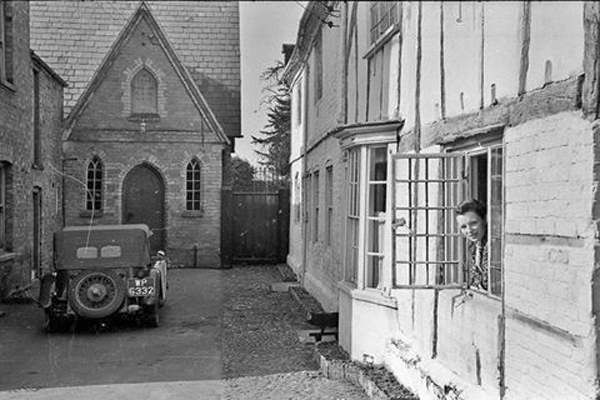
Photo taken in 1952 (courtesy of Michael Leonard), showing 10-12 Church Street on the right (Lot 2 in the sale), the former Girls School in the centre and no.14 on the left
LOT 3. A BRICK-BUILT HOUSE,
Partly thatched and partly slated, partly let to Mr. Harry Ingram at £12 per annum, and part to Henry Scott at 2s 6d per week containing Shop, 2 front Sitting-rooms, back ditto, Kitchen, Scullery, 5 Bedrooms and Cellar, and a brick and thatched Cottage adjoining, let to John Scott, at £4 10s. 0d. per annum, containing 2 rooms below and 2 above. A Court Yard with brick and tiled Slaughter House and Brewhouse, brick and slated Cart Hovel, brick and slated Piggery and a good Garden.
The Court Yard to Scott’s cottage and a piece of garden ground, now let with this property will not be included in this Lot, but is sold with Lot 4, as shown on plan produced at time of sale.
Lot 2 and 3 are sold subject to a joint right of way as shown on plan.
The purchaser of Lot 2 shall erect and forever maintain a substantial fence 6 feet high to divide the Yard on Lot 2 from the Yard on Lot 3, as shown on plan and also by white paint mark.
[handwritten in left margin] & also to erect \substantial/ fence against Lot 5 as per ‘T’ shown on plan.
LOT 4. TWO BRICK AND SLATED COTTAGES
With one room below and one above, let to Stephen Bowden and Mrs. Markham, at 1s. 3d. per week each, with court-yard and Garden.
This Lot is sold with the Court Yard now let with the Cottage to John Scott, and also with a piece of the Garden ground in the occupation of Mr. Harry Ingram, as shown on Plan produced at time of sale and the purchaser of this Lot shall erect a 9-inch brick wall 6 feet high, to divide this Lot from Lot 3, as shown on plan and also by white paint mark.
[handwritten in left margin] Rent £6 10 0
Notes:
These Cottages have no back way and consequently are liable to complaint from the Sanitary Authorities. I would therefore advise that the Court Yard now let with Scotts Cottage be added to this property and I would still further advise that the \a/ piece of garden ground, which is now let to Mr. Harry Ingram be also added and that the purchaser of this lot shall be required to erect and maintain the fence which shall divide it as marked A.B. on the plan annexed
LOT 5. A very valuable Plot of Building or Garden Ground
At the back of Lot 3 and adjoining Lot 2, and having an average width of 66ft. 6ins., and a depth of 231 feet, and containing about 1700 square yards, more or less.
Notes: I would advise the property in the occupation of Mr. George be sold as shown on plan which will give almost a straight line and will include a small portion of the Yard now let to Mr. Harry Ingram. I am of the opinion that if the Orchard is taken away from Mr. Georges occupation it would seriously detract from the value of the remainder of his holding and the extra value that the land might make as Building Land would more than be lost on the depreciation of the House and Buildings. I think however that the orchard in the occupation of Mr Harry Ingram might be sold separately as Building Land in as much as Mr Ingrams House & Building stands on a large piece of Ground and the latter are very old. I therefore think that more money might be made by separating this occupation.
As to Values [these are the numbers on the plan below, not the actual lot numbers]
No. 1 £180 to £200
“ 2 £ 80 to £100
“ 3 450 to 500
“ 4 250 to 280
(5) Paddock 70 to 80
[total] 1030
The Whole of the Properties are Freehold.
[handwritten in right margin] B.G. £85?
NORTH MARSTON. TWO COTTAGES WITH GARDENS,
Situate at North Marston, let to Joseph Linney and Newman Young, respectively at 1s. 2d. per week.
[handwritten in left margin] Rent £6 1 4
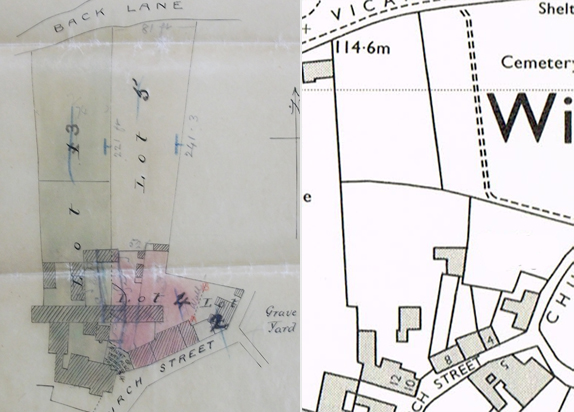
The map on the left is Mr Wigley's draft map for the sale. On the right is the same site in 1978. NB The large number of outbuildings which have now disappeared. The numbers on the map are wrong: Lot 2 on the map = Lot 4 in the sale, Lot 4 on the map = Lot 3, Lot 3 on the map = Lot 2.
Conditions of Sale.
... FOURTH. – The remainder of the purchase-money of each lot shall be paid ; and the purchase thereof shall be completed, on the said 21st day of December next, at the offices of Messrs WILLIS & WILLIS, Winslow, and if from any cause whatever the purchase of any lot shall not be completed on that day, the Purchaser thereof shall pay the Vendors interest after the rate of £5 per cent. per annum on the remainder of the purchase-money from that day until the completion of the purchase. The Purchaser of each lot shall be entitled to the possession or receipt of the rents and profits of the lot purchased by him from the said 21st day of December next, all out-goings up to that day being cleared by the Vendors, and all current rents and outgoings shall be apportioned for the purposes of this condition.
FIFTH. - The Vendors will deliver to the Purchaser of each lot, or his Solicitor, an abstract of title to the lot purchased by him, but the purchaser of more than one lot shall not be entitled to more than one abstract of the common title.
The title shall commence with the Will of a Testator who died in 1859, and the purchaser shall assume without proof of the seisin or ownership of the testator, and the Winslow property which was then copyhold and has since been enfranchised. and also the North Marston property, passed by his Will. The enfranchisement was made by the tenant-for-life under the Will, but the Deed of enfranchisement conveyed the property as freehold to such tenant-for-life in fee simple. The Executrix of such tenant-for-life and the sole beneficiary under her Will, will concur in the conveyance to the purchaser together with the persons now entitled to the shares of the remaindermen under the original testator’s Will as hereinafter mentioned. No objection shall be made in respect of such enfranchisement, and the purchaser shall assume that the remaindermen under the original testator’s Will acquired beneficially absolute freehold estates in the property. One of the persons who became entitled as heir-at-law, of one of the remaindermen under the original testator’s Will, left England about the year 1884, without having, as it is believed, ever married, and he has not since been heard of. A Statutory Declaration as to the facts aforesaid will be made by a sister of such person and one of his Vendors, if the purchaser requires it. The purchaser shall assume that such person was dead, unmarried and intestate in the year 1893, being more than seven years from the date of his disappearance from England, and his eldest surviving brother as his heir-at-law will concur in the Conveyance. The purchaser shall not make any objection in respect pf the above matters. And no Purchaser shall make any objection or requisition in respect of the lot or lots purchased by him prior to the date with which the respective abstract of title is stipulated to commence, whether such prior title appear by recital or otherwise, or does not appear at all. And no evidence shall be required of the payment or discharge of any legacy or sum of money charged on any of the lots, or any duty which became payable 20 years or upwards prior to the day of sale, and no objection or requisition shall be made in respect thereof. All deeds and documents dated prior the 16th May 1888, shall be assumed to have been correctly executed and stamped, and no objection or requisition shall be made in respect thereof.

By 1952 the thatched roofs of 6-8 Church Street had been covered with corrugated iron (photo courtesy of Michael Leonard)
SIXTH.- No Purchaser shall require any other evidence of the identity of the lot purchased by him with any of the property described in the abstracted documents other than a statutory declaration, which will be furnished to him if he requires it at his own expense, that the property has been consistently with the title shown by the abstract for the last 12 years. ...
TENTH.- Upon payment of the residue of the purchase-money at the time and place above mentioned, the Vendors shall make and execute to the Purchasers proper assurances of their respective lots, such assurances to be prepared by and at the expense of the Purchasers, and to be left by them for execution at the office aforesaid not less than seven days before the aforesaid 21st day of December next, and the getting in all of the outstanding estates, terms, and interests shall be at the expense of any Purchaser requiring the same.
ELEVENTH.- Such of the documents of title in the Vendors’ possession as relate to more than one lot shall be delivered to the Purchaser of the largest part in value of the lots to which the same relate, if all such lots shall be sold, but otherwise shall be retained by the Vendors. The Purchaser to whom such documents shall be delivered, or the Vendors retaining the same, shall give to the Purchasers of the other lots to which the same relate, as acknowledgement of their right to production and to delivery of copies thereof, and an undertaking for their safe custody. Every acknowledgement and undertaking under this condition shall be prepared by and at the expense of the person to whom it is given, and shall be perused by or on behalf of the person giving the same at his own expense.
TWELFTH.- If any Purchaser shall fail to comply with these conditions, his deposit money shall be forfeited to the Vendors who shall be at liberty to proceed to another sale, either by public auction or private contract, with or without notice to the Purchaser at the present sale, and the deficiency (if any) occasioned by such second sale, together with all charges attending the same, shall immediately after such sale be made good by the defaulter at this present sale, and in case of nonpayment of the same, the whole shall be recoverable by the Vendors as and for liquidated damages, and it shall not be necessary for the Vendors to tender a conveyance.
1895-1918
14-16 Church Street were sold in 1895 after the death of the owner George Dunkley. Two houses fetched £300 and a brick-built cottage adjoining (presumably incorporated into no.16) £75. They were bought by Matthews Bros. In the 1901 Census there were three lodgers at no.14 including James Alfred Chew, 39, "author (plays)", b. Gateshead. In 1903, E.J. French printed for him That Greenish Family, An American Comedy (new and original) in three acts. The title page dedicates it "To the memory of Mr. H.F., a gallant sport, and the friend who suggested our theme". He was the brother of the pianist Otie Chew, and seems to have followed her to the USA.
In c.1908 the occupiers were Miss Hutt and Robert Turney. In 1919 they were sold for £440 to Mr R.E. Golledge, described as "Two freehold houses situate in Church Street and adjoining Horn Street with a net rental of £32".
George George must have bought 10-12 Church Street at the 1894 sale, but moved to Selby Villa and advertised his previous home to let:
1899: Buckingham Advertiser, 7 Oct
To be let with immediate possession. The house and premises, well adapted for business purposes, lately in the occupation of Mr. GEO. GEORGE, situated in Church Street, Winslow.
The house contains 2 front rooms, entrance hall, scullery, kitchen, with outhouse, w.c., 3 bedrooms, and 2 attics. A cottage adjoining, with good sitting room, kitchen, 2 bedrooms, hovel, and w.c. Also 2 yards, with barns, coach-house, 4 loose boxes, 2 pigsties, a large garden, and 2 small paddocks. The whole property will be let together or in separate lots. For particulars etc., apply by letter to GEO. GEORGE, White House, Winslow. [He got a tenant for house but not cottage.]
1907: Buckingham Advertiser, 25 May
JESSE SMITH & SON, COAL MERCHANTS AND CARTING CONTRACTORS,
Beg to give notice that they have removed from High Street to CHURCH STREET, WINSLOW,
Where they will carry on Business as usual.
All orders to the latter address will receive prompt attention.
1907: Buckingham Advertiser, 15 June
TO LET, a COTTAGE, in Church Street, Winslow, with immediate possession, containing two rooms, two bedrooms and out-house, &c.- Apply by letter to GEO. GEORGE, White House, Winslow.
The whole property was up for sale in 1908, after several earlier attempts.
| A capital Roomy FREEHOLD HOUSE, with Brick and Tiled COTTAGE adjoining, extensive and substantial Outbuildings, Stabling, and Good Garden, situate in Church Street: and a Valuable ACCOMMODATION CLOSE. Forming a highly desirable Building Site, having a frontage of about 154 feet to Vicarage Road. TO BE SOLD AT AUCTION BY Messrs. GEO. WIGLEY & SONS On FRIDAY, September 25th, 1908, At the Bell Hotel, Winslow at Five o’clock EXACT TIME (subject to the conditions and stipulations to be produced at the time of Sale). The PROPERTY COMPRISES - A brick and slated and part tiled private Dwelling House, situate in Church Street, Winslow containing – Good Entrance Hall, Dining Room, Drawing Room, 3 Bedrooms, 3 Attics, brick and slated lean to Kitchen, Scullery, Dairy and Cellar. Two Court Yards surrounded by the following substantial and extensive Buildings:- Large Brick and tiled Granary, 2 Harness Rooms, brick and tiled four-stall Stable with Loft over, brick and corrugated iron roofed Cart Shed, 2 brick and tiled Piggeries with Loft over, brick and slated Hen House, 2 brick and tiled lean-to open Tool Sheds, brick and tiled Stabling, comprising 3 loose boxes with Granary and Loft over. At the back is a good Kitchen Garden and Grass Paddock, extending to the Vicarage Lane. On the east side of the Property is another highly desirable Accommodation Close having considerable building value, with a frontage of about 82 feet to the Vicarage Lane, and having an average depth of about 227 feet, and containing about 1680 square yards (more or less). Adjoining the House is a Brick and Tiled Cottage, containing 4 Rooms and brick and slated Hovel and w.c. adjoining. The House Buildings and Paddocks are now let to Mr. Jesse Smith at a rental of £35 per annum (tenant paying rates), whilst the Cottage is let to Mr. Rupert Stonhill on a weekly tenancy at 3s. 0d. per week (landlord paying rates). There is a pump and well of water on the property. Gross aggregate rental £42 16s. 0d. per annum. The whole of the property is freehold. There is a right of way to the yard and Coach-house at the side. For further particulars apply to Messrs. Hearn and Hearn, Solicitors, Buckingham, or to the Auctioneers, Winslow, Fenny Stratford, and Stony Stratford |
The buyer was Silvanus Jones who paid £472 10s for the whole property. After he died, the houses were up for sale again:
1915, 7 Dec: sale of property of Silvanus Jones [click here for full particulars]
2 capital freehold houses in an excellent state of repair, situate in Church Street, Winslow, with good outbuildings and large gardens, also a range of brick-built stabling and a coach-house adjoining.
[reported on 11 Dec as unsold] Two very compact and comfortable small homes, situate in Church Street ... having recently been put in thorough repair, and having very large kitchen gardens, together with some stabling adjoining.
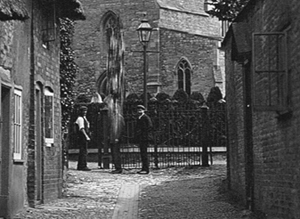 |
This postcard from 1915 shows that there was an iron gate at the end of Church Street by then |
1901 Census
- Horn Street: 1 unoccupied
- Church Street: John Scott, 72, farm lab., b. Winslow + wife (4 rooms) [no.16]
- Robert Turney, 42, b. Hollingdon + wife, 3 children, 3 boarders [no.14]
- John Fountain, 36, stud groom, b. Ramsey Hunts + wife, niece [nos.10-12?]
- Harry Scott, 36, carpenter, b. Winslow + wife, 5 children [no.8]
- Amos Watson, 56, cowman, b. Water Stratford + wife, 4 children [nos.4-6]
- Louisa Smith, unm, 42, dressmaker, b. Melksham, Wilts (4 rooms) [no.2? This entry is out of sequence and could refer to no.4]
- William Rolfe, 38, bricklayer, b. Waddesdon + wife, 7 children, lodger [no.1]
- William Mumford, 34, baker, b. Stony Stratford + wife, 3 children [location unclear]
Owners and occupiers in the 1910 Survey and 1911 Census
| House | Occupier | Occupation | No. of rooms | Owner (c.1908) |
| 1 Church Street | William Rolfe | Bricklayer | 8 | Mrs M.A. Jones |
| 2 | Frederick Walker | Farmer | 4 | W.J. Matthews |
| 4 | Aubrey Wright | Cowman | 4 | E.A. Illing |
| 6 | John Willmore | Grocer's porter | 6 | E.A. Illing |
| 8 | Robert Dickins | Baker | 4 | E.A. Illing |
| 10 | Jesse Smith [arrived in 1907] | Farmer | 10 | George George |
| 12 | Rupert Stonell | Postman | 4 | N. McCorquodale |
| 14 | Frank Gutteridge | Grocer's assistant | 6 | Matthews Bros |
| 16 | Frederick Puffett | Stud groom | 7 | Matthews Bros |
After World War One
1921 Census
| House | Occupier | Occupation | No. of rooms |
| 1 Church Street | William Rolfe | Builder's foreman for F.J. Walker, St. Claydon | 8 |
| 2-6 | James Adams | Bricklayer's labourer for H. Lacey & Sons, Luton | 2 |
| William Norman | Cattle drover, own account | 4 | |
| Rebecca Walker | Widow | 4 | |
| John Wilmore | Grocer's carrier for E.A. Illing | 5 | |
| Frederick Seaton | Bootmaker, own account | 4 | |
| 8 | Robert Dickins | Journeyman baker for H.J. Paine | 4 |
| 10 | Frederick G. Hancock | Smallholder | 7 |
| 12 | William James Stevens | Shoeing & general smith for Edward Wilson | 6 |
| 14 | Emily Finch | Dressmaker | 6 |
| 16 | Elizabeth Adams | Home duties | 6 |
2 Church Street was sold by Matthews Bros in 1922. The Buckingham Advertiser reported (8 July):
The pretty little creeper-clad cottage standing in a small garden at the top of Church Street, and recently occupied by Mrs. Walker, was disposed of by auction ... and realised the excellent sum of £287 10s., the purchaser being Mr. Sargent, of London.
The Sargents named it Pear Tree Cottage. It was for sale again after the death of Augustine Frederick Sargent, and was bought for Hilda Hubbard, a member of the family of Lord Addington and prominent Labour activist.
Buckingham Advertiser, 3 Jan: The picturesque detached cottage PEAR TREE COTTAGE, CHURCH STREET containing Entrance Lobby, Sitting Room, Kitchen, Pantry, Scullery and 2 Bedrooms, Coal Store and Modern Conveniences, Small but Attractive Garden.
24 Jan: Messrs. Geo. Wigley offered for sale Pear Tree Cottage, Church Street ... there was keen interest and bidding for Pear Tree Cottage, which was offered with vacant possession. The property was finally knocked down to Mr. Philip Wood of Messrs. Philip Wood & Dawson, on behalf of a client, for the price of £1,025.
1 Church Street was inherited by Edith Jones and her sisters. In 1919 it was described as being "in a very indifferent state of repair" (read more). The Freemasons bought it and in 1930 built Eliot Hall in the garden.
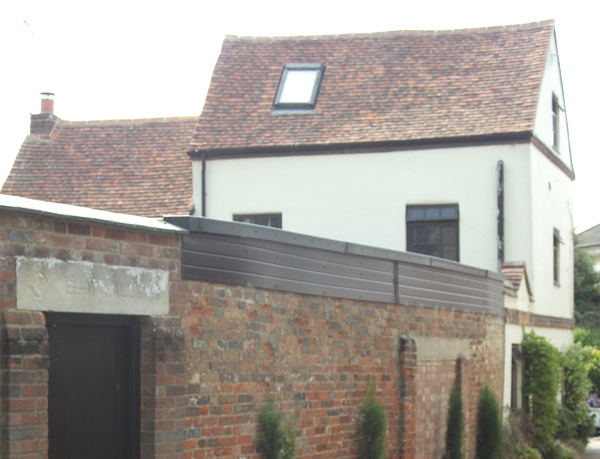
1 Church Street and the entrance to Eliot Hall (2016)
10-12 Church Street was bought in 1932 by Captain Robert Sutherland Rattray, who renamed it the Old Homestead. He has his own entry in the Oxford Dictionary of National Biography as "colonial official and ethnographer"; he was an expert on what is now Ghana. He was a friend of the aviatrix Amy Johnson (1903-41), who visited his house and made an appearance at the Whitsun fete in 1932. He was killed in a glider accident in 1938.
Buckingham Advertiser, 21 May: Capt. Rattray had been very popular in Winslow during his few years of residence there, and the old house which he bought and restored to its 16th century appearance is one of the most interesting in the town. It was filled with interesting treasures and curios relating to his many-sided travels, sports and adventures.
